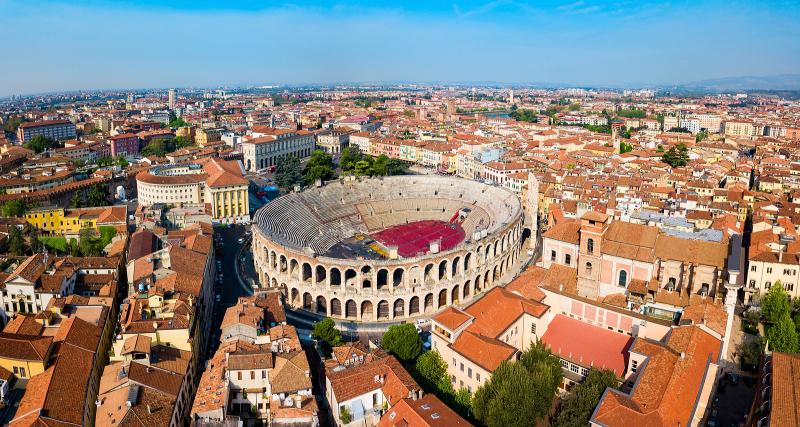Wonders of Italy: The Verona Arena
ITA:

One of the most fascinating monuments of ancient Roman times, the Arena di Verona is a large amphitheater located in the historic center of Verona, a true icon of this Veneto city along with the figures of Romeo and Juliet.
Typical of Roman architecture, the Arena di Verona has been exceptionally well preserved, thanks also to the regular restorations carried out since the 16th century. It is the third largest Roman amphitheater in Italy, after the Colosseum in Rome and the Capua Amphitheater near Naples.
The lack of written sources about the inauguration of the amphitheater makes it difficult to date it precisely, although it is thought that it was built in the first century, under emperor Augustus.
When it was built, it stood just outside the walls of the ancient city, to facilitate the flow of spectators and prevent overcrowding in the urban center. Later, it was incorporated within the walls built by Roman emperor Gallienus to defend the city from Barbarian attacks.
Like the Colosseum, the Arena was used for entertainment, including gladiator fights. These took place in the center of the amphitheater, in the area called harena (hence the name Arena), where there was sand, which was used to absorb blood of both men and animals. These gory spectacles were highly appreciated by the ancient Romans.
Over the centuries, the Arena has been used for the most diverse of reasons: as a stone quarry for the construction of houses nearby; for the administration of justice, including stakes; for shows, parties and races; it was even said that at some point, prostitutes were relegated there, later driven out and replaced by craft shops.
The amphitheater originally had a capacity of 30,000 spectators; today, it can hold about half of that, for scenic and safety purposes.
The first opera to be performed at the Arena di Verona was Giuseppe Verdi's Aida, in 1913, one of the most grandiose international shows of the 20th century, attended by people from all over Italy and Europe.
Since then, every summer, the Arena has been home to the Arena Opera Festival, which has an attendance of 600,000 spectators over 50 evenings with five or six alternating productions.
Tra i monumenti più affascinanti della romanità antica, l'Arena di Verona è un grande anfiteatro situato nel centro storico di Verona, vera icona di questa città veneta insieme alle figure di Romeo e Giulietta
Tipica dell'architettura romana, l'Arena di Verona si è eccezionalmente ben conservata, grazie anche ai regolari restauri effettuati a partire dal XVI° secolo. È il terzo anfiteatro romano più grande d'Italia, dopo il Colosseo a Roma e l'Anfiteatro di Capua vicino a Napoli.
La mancanza di fonti scritte sull'inaugurazione dell'anfiteatro rende difficile datarlo con precisione, sebbene si pensi che sia stato costruito nel I° secolo, durante il regno dell'imperatore Augusto.
Quando fu costruito, sorgeva appena fuori le mura della città antica, per facilitare il flusso di spettatori e impedire gli affollamenti nel centro urbano. Successivamente fu inglobato all'interno delle mura costruite dall'imperatore romano Gallieno per difendere la città dagli attacchi dei Barbari.
Come il Colosseo, l'Arena era utilizzata per spettacoli di intrattenimento, comprese le lotte dei gladiatori. Queste avvenivano al centro dell'anfiteatro, nella zona chiamata harena (da cui il nome Arena), dove era presente la sabbia, che serviva ad assorbire il sangue (di uomini e animali). Questi spettacoli cruenti erano molto apprezzati dagli antichi romani.
Nel corso dei secoli l'Arena è stata utilizzata per i più svariati motivi: come cava di pietra per la costruzione di case nei dintorni; per l'amministrazione della giustizia, compresi i roghi; per spettacoli, feste e gare; si diceva addirittura che a un certo punto le prostitute venissero relegate lì, in seguito cacciate e sostituite da botteghe artigiane.
L'anfiteatro originariamente aveva una capacità di 30.000 spettatori; oggi ne contiene circa la metà, a fini scenografici e di sicurezza.
La prima opera ad essere rappresentata all'Arena di Verona fu l'Aida di Giuseppe Verdi, nel 1913, uno dei più grandiosi spettacoli internazionali del XX° secolo, a cui parteciparono persone provenienti da tutta Italia ed Europa.
Da allora, ogni estate, l'Arena è sede dell'Arena di Verona Opera Festival, che conta 600.000 spettatori in 50 serate con cinque o sei produzioni che si alternano.











